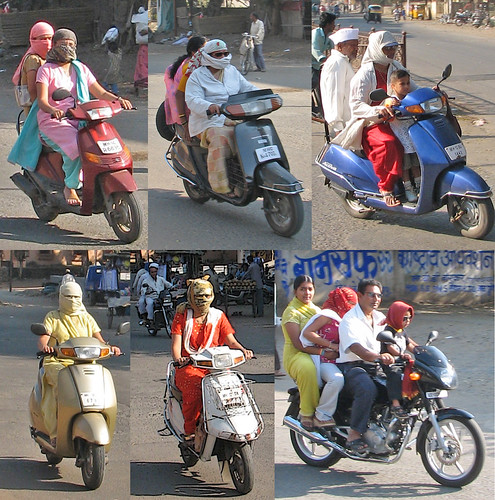By Soroor Ahmed, TwoCircles.net
Modern girls from Indian metros may soon pose a big challenge to authorities in France and Belgium, who are busy implementing new rules on hijabs and burqas. If our latest fashion remains unchecked and crosses the international boundaries of these two European countries––and of course many others––then they may soon be flooded by ‘masked girls’ from India.
A fashion, which is said to have originated in Pune in Maharashtra a few years back, has spread deep into various nooks and corners of India. Modern young girls clad either in jeans, shorts, skirts or shalwar-jumper etc can be seen everywhere with their entire face and head tightly covered with dupatta (long-scarf)––in most cases black. They are seen riding moped, pedaling down to college on cycle or strolling in the park or coming out from theatre or shopping-mall with friend(s)––mostly boy(s).
The entire face and head are so tightly shrouded that even the eyes are barely visible. Often their movements raise suspicion among the people. Sometimes it would really become difficult to differentiate whether a person with tightly covered head and face and dressed in skin-tight jeans and tops is a boy or a girl.

Photo by Eric Parker
Unlike burqa, which covers the entire body and is loose, these masks are air-tight, yet the fashion is catching up fast. One fails to fathom as to what prompted millions of girls in India to suddenly adopt this fashion. If they really think that they should cover their face, hair and head than their entire dress should be modest too. But if they want to hide their identity for some devious purpose than it is entirely different matter.
In the beginning it was argued that in Pune girls would wear it because of heat and environmental pollution. But then Pune is not the hottest and most polluted city of India or the world. And even if it is true then why is it that the girls wear them in winter? Now the fashion has spread to many parts of India, where the climatic condition is different.
If these girls are so much conscious about their face and want to keep it free from sun-burn they should wear it more decently rather than like the criminals, who do not wish to be identified.
Nobody will dare to suggest them to wear burqa, but then they should wear more acceptable head-gear or face-cover than the one which they are sporting in India these days.
The feminists and women’s right activists are silent over this growing phenomenon, but one may dare to ask them: who imposed such a ‘veil’ on the liberated modern Indian girls. They were certainly not impressed by any religious scripture nor were forced by clergy, father, brother or boyfriend to do so.
While Islam calls upon girls and women to be modestly dressed, when out of the house, and there are two opinions about the purdah (covering) of face, traditional Hindu women still put ghunghat over their face. Still none, perhaps not even in Taleban’s Afghanistan women or girls put their face behind such a tightly-wrapped veil.
Draping the face so tightly with a piece of cloth is not only harmful for health and face, it causes breathing problem and suffocation too, yet it is in-thing in our fashion-world. The champions of women’s right, who would blast Muslim male for putting their women behind the veil even during the summer season, are yet to counsel these girls to avoid wearing such headgear, at least for the sake of health.
The battle of dresses is not a new one. Different civilizations have imposed their own dress-code and culture. Sometimes they are even borrowed and incorporated from alien culture. For example, sari with blouse and petticoat is a new fashion. Earlier Hindu men and women would not wear stitched clothes.
Women all over the world generally used to wear fully covered dresses till 19th century. In the same way the modern day full-pants have more to do with the Turkish trousers as before 19th century there was no such dress like pantaloons common in Europe.
However, during the Industrial Revolution the skirts started becoming shorter only to reach above knees. This has more to do with the growing stranglehold of capitalism in 19th century Europe and US rather than Christianity. The capitalists and feudal-lords would employ women workers at half the wages with the condition of wearing shorter-skirts.
The plea was that mini-skirts––and that ironically too in the countries falling in extreme cold condition––will help them work efficiently. However, the real objective was something else. In the name of women’s emancipation the capitalists would actually use girls and women to mint money as they are doing so now.
One do not need to read any Holy scripture to understand it. Karl Marx in his Das Kapital discussed this aspect and exposed the real design of those engaged in money begets money business.
In the name of liberalism and the women’s rights the capitalists have made a big in road. Their money power has blinded the thinking of intellectuals, academics and media persons. They would go on writing pages after pages against the burqas and head-scarves while, at the same time, never ban the habits worn by the Christian nuns, though there is hardly any difference between the two.
While there is general trend of fusion of dresses of different cultures, many in the West want to impose their own on others. They would go on poking fun on the burqa-clad ladies and suspect them as ‘terrorist’ yet would remain completely silent over these funny-looking girls whose movements often raises suspicion among the people.
